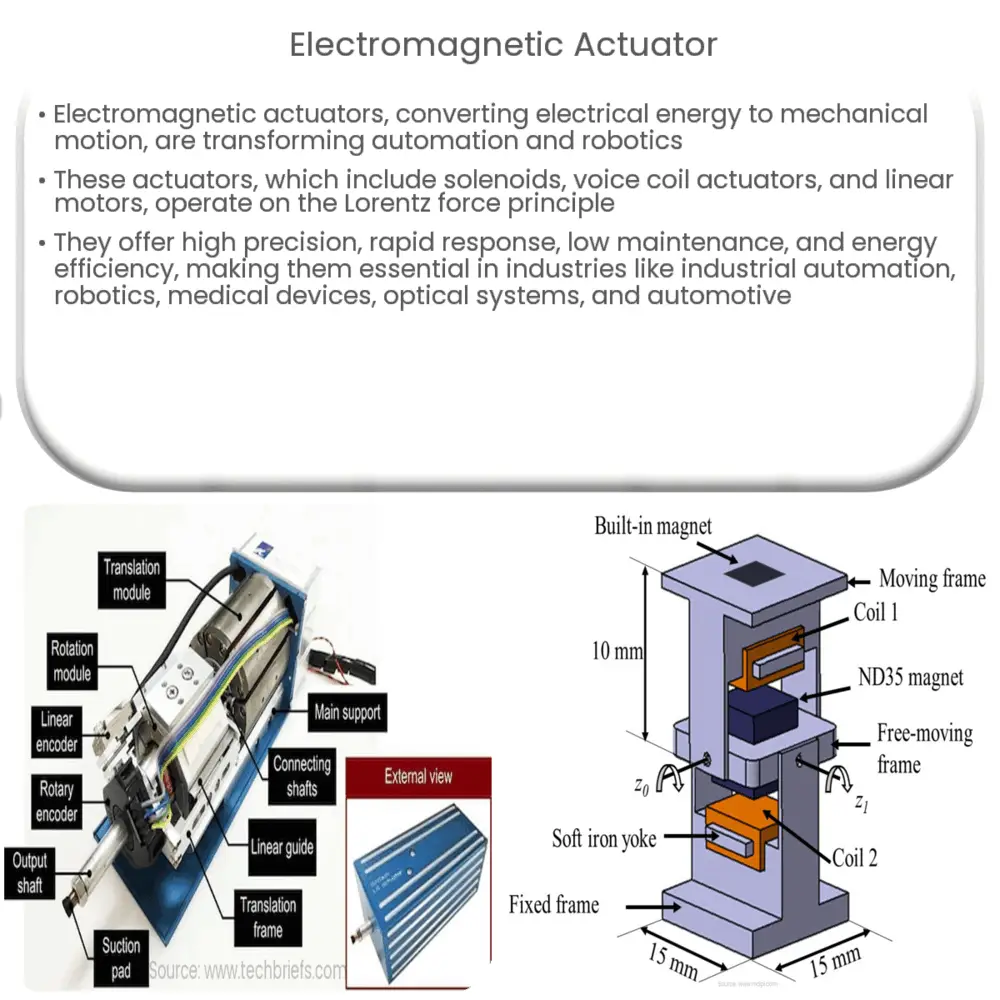Electromagnetic actuators convert electrical energy into precise mechanical motion, revolutionizing automation, robotics, and various industries.

Electromagnetic Actuators: Revolutionizing Automation and Robotics
Introduction
Electromagnetic actuators have been steadily gaining traction in the fields of automation and robotics, revolutionizing the way machines and devices operate. These devices convert electrical energy into mechanical energy, allowing for precise control and movement in various applications. This article will explore the fundamentals of electromagnetic actuators, their working principle, and their applications in modern technology.
What is an Electromagnetic Actuator?
An electromagnetic actuator is a type of actuator that relies on the interaction between magnetic fields and electric currents to generate motion. This class of actuators includes solenoids, voice coil actuators, and linear motors. They are widely used in a range of applications, from simple switches to complex robotic systems, due to their high precision, reliability, and energy efficiency.
Working Principle of Electromagnetic Actuators
The fundamental principle behind electromagnetic actuators is based on the Lorentz force. When an electric current flows through a conductor, it generates a magnetic field around it. When this conductor is placed within an external magnetic field, the interaction between the two fields produces a force that acts on the conductor, leading to motion. This force, known as the Lorentz force, is directly proportional to the current flowing through the conductor and the strength of the external magnetic field.
In an electromagnetic actuator, a coil of wire (the conductor) is wrapped around a core, typically made of iron or another ferromagnetic material. When an electric current is passed through the coil, a magnetic field is generated around the core, which interacts with an external magnetic field created by permanent magnets or other coils. This interaction generates a force that moves the core or other attached components, creating mechanical motion.
Types of Electromagnetic Actuators
There are several types of electromagnetic actuators, each with their unique characteristics and applications. Some of the most common types include:
Solenoids
Solenoids are the simplest type of electromagnetic actuator, consisting of a coil of wire wrapped around a movable plunger, usually made of ferromagnetic material. When an electric current is applied to the coil, a magnetic field is generated, causing the plunger to move linearly. Solenoids are commonly used in applications such as valves, switches, and relays.
Voice Coil Actuators
Voice coil actuators are similar to solenoids but offer more precise control over the generated motion. They consist of a coil of wire, a magnetic field source (usually a permanent magnet), and a guided shaft that moves linearly when the coil is energized. Voice coil actuators are widely used in applications requiring high precision and fast response times, such as optical systems and robotic systems.
Linear Motors
Linear motors are electromagnetic actuators that generate continuous linear motion rather than short, discrete movements like solenoids or voice coil actuators. They consist of a stator, which produces a magnetic field, and a movable slider or armature that is propelled by the interaction between the magnetic fields. Linear motors offer high-speed, high-precision motion and are commonly used in industrial automation, transportation, and robotics applications.
Advantages of Electromagnetic Actuators
Electromagnetic actuators offer several benefits over other types of actuators, such as hydraulic or pneumatic systems. Some of the key advantages include:
- High Precision: Electromagnetic actuators can provide very precise and accurate motion control, making them ideal for applications where precision is crucial, such as medical devices, optical systems, and robotics.
- Fast Response Times: These actuators can achieve rapid response times, allowing for quick and efficient motion control in dynamic applications.
- Low Maintenance: With few moving parts and no requirement for fluids or compressed air, electromagnetic actuators require minimal maintenance compared to hydraulic or pneumatic systems.
- Energy Efficiency: Electromagnetic actuators are more energy-efficient than other actuation methods, as they convert electrical energy directly into mechanical energy with minimal losses.
Applications of Electromagnetic Actuators
Electromagnetic actuators are used in a wide range of applications across various industries. Some of the most common applications include:
- Industrial Automation: These actuators are used in manufacturing equipment, conveyors, and pick-and-place systems for precise and efficient control of motion.
- Robotics: Electromagnetic actuators play a crucial role in the movement and control of robotic arms, grippers, and other robotic components, enabling precise and repeatable motion.
- Medical Devices: Precision and reliability are critical in medical applications, making electromagnetic actuators an ideal choice for use in devices such as surgical instruments, drug delivery systems, and diagnostic equipment.
- Optical Systems: In optical systems like cameras, microscopes, and telescopes, electromagnetic actuators enable fine control over focus and positioning of lenses and mirrors.
- Automotive: These actuators are utilized in various automotive systems, such as throttle control, transmission systems, and active suspension, to enhance vehicle performance and efficiency.
Conclusion
Electromagnetic actuators have revolutionized the fields of automation and robotics by providing high precision, fast response times, low maintenance, and energy-efficient motion control. Their versatility and wide range of applications make them an integral part of modern technology, driving advancements in industries such as industrial automation, robotics, medical devices, optical systems, and automotive systems.

